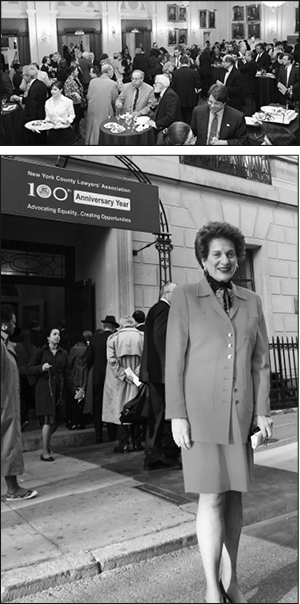By James S. Woodman
Emerging from a mass of black suits, New York State’s Chief Judge Judith Kaye took the altar at St. Paul’s Chapel, and, after a few remarks, launched into a song:
We’re so grateful
and you’re so faithful
That we pride this day
We treasure your bounty
in New York County
We love the N.Y.C.L.A.
Breaking her jovial tone, Kaye recalled a time only decades ago when the New York County Law Association was very much alone in decreeing equality — of race, gender, religion and ethnicity — in the legal profession. “For a century, NYCLA has truly been a shining beacon,” Kaye said. “And I do remember those dark, dark days.”
To Kaye, who belonged to a struggling minority of female attorneys 38 years ago, NYCLA’s 100th anniversary meeting carried a personal significance. “NYCLA has always been where openness and diversity was the message,” she told Downtown Express.
NYCLA is a Downtown organization that has little difficulty drawing far-flung high officeholders to deliver silly ballads and grant profound historic gratitude. As so, it also seemed of no surprise when, just before Kaye’s address, a representative of Mayor Bloomberg, unveiling a poster-sized proclamation, declared May 22 to be NYCLA Day in New York City.
Even as Lower Manhattan has lost many of its large law firms, the centennial celebration offered another affirmation that NYCLA is nevertheless one of the city’s foremost bar associations. “I belong to five or six bar associations,” member Alan Kahn said. “But NYCLA is where I go by default.”
In 1907, a group of progressive-minded lawyers gathered in Carnegie Hall to discuss establishing a bar association that would split dramatically from the discriminatory status quo, according to NYCLA.
At that time, Lower Manhattan was the nerve center for most American law firms; and none of New York’s bar associations allowed women or people of color.
Preceding the association’s founding on April 21, 1908, Joseph H. Choate, who would later become president of NYCLA, declared the new association’s membership policy: “any attorney who had met the rigid standards set up by law for admission to the bar should, by virtue of that circumstance, be eligible for admission.”
If the new association’s emphasis on integration risked labeling it as politically radical, its loudly publicized anti-socialist sentiments helped to align it with the mainstream. A 1908 New York Times article covering the association’s formation titled “New Lawyer League To Shun Reformers” spoke mainly about NYCLA’s revulsion to far-left politics. “Socialism qwto-day is an existing and actual menace,” founding president, John Dillion was quoted as saying. “Against all such sources of danger we must guard with sleepless vigilance and fidelity.”
Yet, while the news media covered the new association’s more conservative principles, NYCLA was drastically reforming the legal profession in New York City.
By 1929, of 6,007 members, the association had 152 women, which was not trivial for the time.
At a time when the military and Major League Baseball were still segregated, NYCLA admonished the American Bar Association in 1943 for refusing admittance to black lawyer Francis E. Rivers due to his race. According to the New York Times, NYCLA threatened to sever its membership with the American Bar unless it reversed its policy of barring black lawyers.
The bar eventually yielded under NYCLA’s pressure. With his subsequent admission to the American Bar, Rivers became not only the first black member of the American Bar Association but also went on to serve as one of the city’s first black judges. Rivers was a longtime NYCLA member.
In this decade, NYCLA sued successfully to raise the pay of lawyers representing indigent defendants and came out in favor of same sex marriage in 2003.
NYCLA’s centennial anniversary also saw member Ann Berger Lesk take the reigns of the association as its new president. Briefly praising a few of NYCLA’s historic endeavors, Lesk said she would rather “not dwell on the past.” To kick off the association’s second century, Lesk said she wants to work on new legal problems faced by sub-prime mortgage practices. “Many people are facing the loss of their homes.”
Lesk also committed to a project that would help protect judges against media attacks carried out in the wake of contentious decisions.
She also has more mundane considerations. Lesk hopes to raise $5 million for renovations on the roof and exterior of the association’s headquarters.
After the meeting in St. Paul’s, a red carpet guided attendees directly across Vesey St. for a gala ball in NYCLA’s headquarters, the Home of Law. Designed by Cass Gilbert — the famous skyscraper-pioneering architect who also designed the nearby Woolworth’s Building — the landmark NYCLA building has served as the association’s headquarters since the early 1930s. The House of Law has a 240,000-book library and an auditorium whose architecture was modeled to mirror Independence Hall in Philadelphia.
In addition to varying legal projects based in the House of Law, NYCLA’s members hold its pro bono services dearly. NYCLA opens its doors to low-income New Yorkers needing legal guidance in matters ranging from divorces to drivers licenses to guardianship issues.
The NYCLA building also gives lawyers a chance to come together in a less formal, non-completive setting. Outgoing NYCLA president Catherine Christian credited this aspect of the organization with her joining in the late 1980s. “It’s a chance to get in touch with, not just your own group, but the larger legal community,” Christian said.
After shifting her presidency to Lesk, Christian — the association’s first African American president — voiced continuing appreciation for the association. “Our theme is not phony, it is the real deal, and I am living proof,” Christian said.
Chief Judge Kaye also believes that the group’s mission remains as vital as ever. “The battle is far from over — we still have a long way to go,” she said in a telephone interview. “And that’s why I associate with NYCLA.”
































